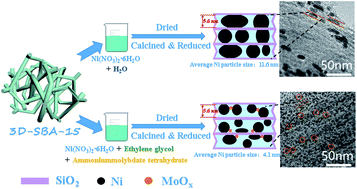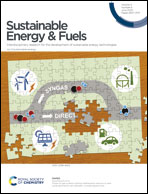A MoOx-doped Ni/3D-SBA-15 catalyst for CO methanation: the effect of a solvent and a MoOx promoter on the catalytic properties
Abstract
A series of MoOx doped Ni/3D-SBA-15 catalysts with a three-dimensional network structure were prepared by an impregnation method using different solvents for CO methanation. It is a challenge to simultaneously improve the low-temperature activity and long-term stability of the catalyst for a high-temperature reaction. In this work, MoOx-doped Ni/3D-SBA-15 catalysts with a three-dimensional network structure were prepared by an impregnation method using ethylene glycol as a solvent for the CO methanation reaction. In addition, H2O was used as a solvent for comparison. The catalyst prepared in the presence of ethylene glycol, shows high specific surface area, small Ni particle size, and high metal dispersion. The addition of the Mo promoter can further improve Ni dispersion and decrease the interaction between NiO species and the support. After reduction under a H2 flow at 600 °C, the Mo promoter is in the mixed valencies in the form of MoOx (x < 3), which can increase the density of Ni atomic electron clouds. As a result, the Ni–MoOx/3D-SBA-15 catalyst exhibits the highest low-temperature activity, whose CO conversion reaches 99.3% at 320 °C, 0.1 MPa, and 60 000 mL g−1 h−1. During the 100 h-lifetime test, this catalyst exhibits high stability due to the small Ni particle size, appropriate metal-support interaction, the promotion of MoOx species as well as the confinement effect of 3D-SBA-15 support.



 Please wait while we load your content...
Please wait while we load your content...